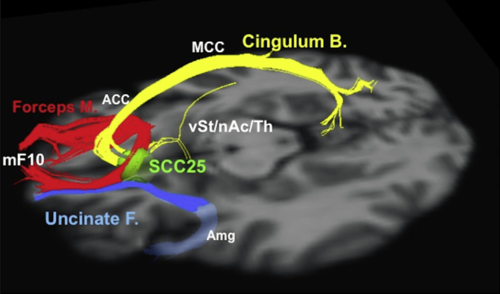Helen Mayberg's treatment for treatment-resistent depression
Chapter 4 endnote 54, from How Emotions are Made: The Secret Life of the Brain by Lisa Feldman Barrett.
Some context is:
During surgery, [neurologist Helen] Mayberg works with a team of neurosurgeons who drill small holes in the skull and sink electrodes into a key predictive area in the patient’s interoceptive network.

Specifically, the electrodes are placed into bundles of axons that connect a specific body-budgeting region—the subgenual anterior cingulate cortex, or sACC—to other regions within the interoceptive network, as well as to other intrinsic networks.[1][2] Mayberg stimulates a spot where three large tracts of axons intersect (forceps minor, which connects the sACC to vmPFC; uncinate fasciculus, which connects sACC to amygdala and anterior insula; and, the cingulum bundle, which connects sACC with the rest of the cingulate cortex). Patients remain awake during the surgery so that Mayberg can ask them how they are feeling once the electrodes are turned on and bursts of electricity stimulate the axons.
Notes on the Notes
- ↑ Choi, Ki Sueng, Patricio Riva-Posse, Robert E. Gross, and Helen S. Mayberg. 2015. "Mapping the “Depression Switch” during intraoperative testing of subcallosal cingulate deep brain stimulation." JAMA Neurology 72 (11): 1252-1260.
- ↑ Riva-Posse, Patricio, Ki Sueng Choi, Paul E. Holtzheimer, Cameron C. McIntyre, Robert E. Gross, Ashutosh Chaturvedi, Andrea L. Crowell, Steven J. Garlow, Justin K. Rajendra, and Helen S. Mayberg. 2014. "Defining critical white matter pathways mediating successful subcallosal cingulate deep brain stimulation for treatment resistant depression." Biological Psychiatry 76 (12): 963–969.